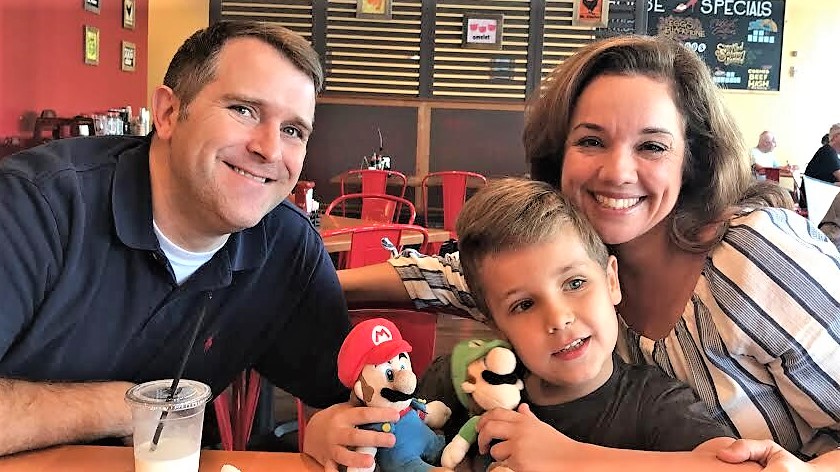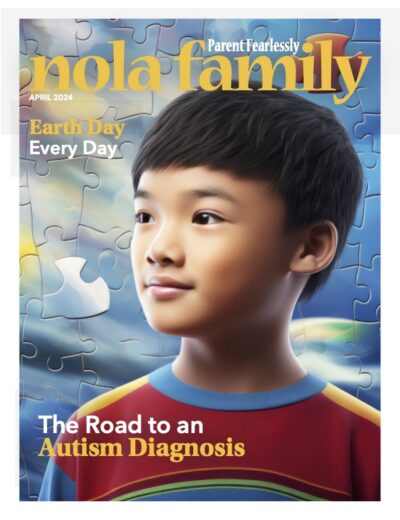
Applied Behavioral Analysis: A Family’s Journey
“ABA provides a structure for learning that Liam responds to.”
by Pamela Marquis, April 9, 2019
Applied behavior analysis is considered the gold standard for children with an autism spectrum disorder, but what is it?
It’s a rainy Sunday and 8-year-old Liam Collins is playing “Super Mario Bros. U Deluxe” on his gaming console. Like most children, Liam is obsessed with video games. He also loves food — so much so that he sometimes hums when he’s tasting something especially delicious.
He’s very smart and is above grade level in reading and at grade level in math. Liam is a bright boy, but he has an autism spectrum disorder — an umbrella term that could include autism, Asperger syndrome, and pervasive developmental disorders.
His parents, Amy and Sherwood Collins, founders of Tres Doux Foundation and Beignet Fest, which raises awareness and funds for autism programs in New Orleans, knew at about 18 months that something wasn’t quite right with their son.
Liam wouldn’t speak to anyone and he didn’t answer to his name. By age 3, they had a diagnosis.
According to the Centers for Disease Control and Prevention, 1 in 59 children is diagnosed with an autism spectrum disorder. It is the most common disability cited for special education students in Louisiana public schools.
“Having a child with a developmental delay requires accommodations that typical children do not need,” Amy says. “Imagine trying to teach a kid to swim when all they want to do is curl up into a ball in the water? Or how do you advise a kid to be part of a group task when they are traditionally stuck in their own little world?”
Liam receives occupational therapy and speech therapy. He’s also using applied behavior analysis, which is considered the gold standard for treating an autism spectrum disorder.
What is ABA?
ABA is a science devoted to improving socially significant behavior. For children with autism, these behaviors include such things as socialization, communication, and daily living skills such as dressing. For these children, tantrums sometimes serve as a means to communicate with parents and caregivers.
ABA-based interventions work to replace these behaviors with more functional and effective means of communication.
“ABA is an important tool because it has several decades of solid research and its data-driven,” says Brian Esteve, a licensed psychologist and behavior analyst. He is also the clinical director of the Gulfsouth Autism Center. “Data on the clients is always being evaluated to measure their progress.”
At his clinic, clients range from 18 months to 12 years of age and beyond. This allows therapy to begin addressing behaviors during early development and helps ensure their clients have both a running start and the ongoing reinforcement needed to reach their optimum level in communication, developmental, social, and educational skills.
“ABA provides a structure for learning that Liam responds to,” Amy says, who takes Liam to Behavior Teaching Concepts in Metairie. “It’s based on scientific evidence. There are a lot of really exploratory things out there that are not. We like that ABA is proven effective. And we see that it is with Liam.”
Many, if not most, children who receive intensive ABA training learn to behave more functionally, at least some of the time, and some even improve to such a degree that ABA is no longer needed, but this happens only after years of intensive therapy.
“Make sure you use reinforcement for actions you want to see,” Esteve says. “Try to always use positive reinforcement, a consistent routine and start small, and most importantly, don’t give up.”

Continuing the Journey
When Amy asks her son what he’s working on now with his therapists, he pauses and looks off in the distance as though he hadn’t heard the question. It’s difficult for Liam to have conversations as he doesn’t always get out what he wants to say.
She patiently says that it’s okay. He could answer the question at another time. Then Liam gets a mighty smile on his face and jubilantly screams, “money!”
“We are also working right now on Liam regulating his emotions when he’s upset,” she says. “He has intense reactions and yells or wants to punch a wall or table with his fist. So, we talk him through taking calming breaths. We’ve used ABA concepts with social stories to work through this, and it generally helps. This is a work in progress.”
The only downside she sees is that the therapy is expensive. Therapy sessions usually occur three to five times per week, for two or more hours per session.“Even covered by private insurance, it’s still a heavy lift,” she says. “Insurance pays 80 percent on our plan, so that means we cover the other 20 percent. It’s about $12,000 a year for us.”
Gulfsouth’s staff assists in determining the best therapeutic course for each client, which could include a combination of ABA and other therapies. Esteve says that a collaborative treatment model with teachers, parents, caregivers, and therapists working together is critical to success.
“Sometimes a brother and sister will be playing well together and the parent will say, ‘This makes me so happy, but if I say something it will disrupt it,’” Esteve says. “But that’s exactly when the parent should say, ‘I like the way you are playing together. Thank you for this great behavior.’”
When finding the right ABA therapist or clinic, Esteve recommends going about the search the same way you would look for a pediatrician or a dentist.
“See if that person is a good fit for your family and a good fit for your child and then give it a try.”
For further reading and more resources on special needs, check out Dr. Pat Blackwell’s Learning Years columns on the Challenges Facing Siblings of Special Needs Kids and Understanding Autism, and one writer’s experience on Choosing a Sitter When your Child has Autism Spectrum Disorder.

